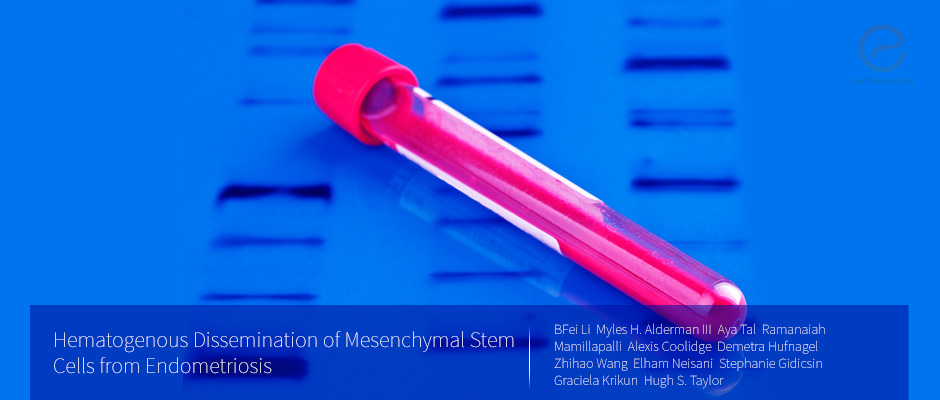Mechanism for Migration of Endometriosis Cells in the Body
Apr 17, 2018
CXCL12 can lead to endometriosis-derived Stem Cells entry into the circulatory system, which can then lead to dissemination of the disease through the body.
Key Points
Highlights:
- The researchers hypothesized that mesenchymal stem cells (MSCs), derived from endometriosis, travel through vascular circulation and create new lesions and also affect distant pre-existing endometriosis.
Importance:
- Researchers have yet to elucidate the mechanism(s) that underlie endometriosis disease progression. If researchers can clarify them, they can target those mechanisms and stop the initiation and potential spread of the disease.
What’s done here?
- The researchers established experimental endometriosis in mice by transplanting DsRed+ endometrial tissue from one mouse to peritoneal cavity found in DsRed- mice.
- After surgery, Flow cytometry analysis was conducted at various time points to analyze the presence of DsRed-positive cells in the peripheral blood.
- The sorted circulating ectopic cells were subject to Fluorescent-Immunocytochemistry (FICC).
- Paraffin-embedded tissue immunofluorescence used to analyze the uterine horn, lung, and spleen that was removed from each mouse.
- Diestrous uteri were isolated and then subject to endometriosis induction. The lesions were then removed and analyzed for Differentiation into multiple mesenchymal lineages, and image
- The study also had human samples. This part collected blood samples from women who had previously undergone laparoscopy.
- Circulating CXCL12 (SDF-1) concentration as well as other markers including inflammatory and stem cell markers such as ß-actin, CD90, CD105, CD9, CD45, CD34, Oct-3/4, CXCR4, examined.
Key results:
- The circulating donor cells did not express the hematopoietic stem cell markers, but they did express CXCR4 and MSC biomarkers.
- The circulating endometrial stem cells were found to originate from endometriosis and not the uterus.
- The recipient mouse’s peritoneal wall and surrounding vessels contained cells expressing DsRed, CXCR4, and MSC markers. These cells help with endometriosis and angiogenesis.
- Lung lesions had differentiation markers, means that these cells still possess multi-potency.
- When experimented on outside the organism, the cells were found to be multipotent. They could differentiate into the following lineages: adipogenic, osteogenic, and chondrogenic.
- Lesions stemming from endometriosis had high expression levels of the CXCR4 receptor ligand, CXCL12. This pattern was observed in mice and humans.
- Endometriosis derived stem cells infiltrate the circulatory system because of CXCL12, which is increased in endometriosis.
Limitations of the study:
- The sample size utilized in the study was small, which means that the investigation is susceptible to any skews in the data.
Lay Summary
Li et al. recently published a paper in Stem Cells titled “Hematogenous Dissemination of Mesenchymal Stem Cells from Endometriosis.” This article seeks to understand the mechanisms underlying the migration of endometriosis. The authors initially hypothesize that endometriosis-derived mesenchymal stem cells (MSCs) can travel through the circulatory system. This mechanism allows the creation of new lesions and enables the interactions between distant pre-existing endometriosis.
The researchers used mouse models to establish experimental endometriosis in mice. They collected blood from these mice, subjected to Flow cytometry and analyzed DsRed-positive cell levels in the peripheral blood. Circulating ectopic cells also sorted, and were later subjected Fluorescent-Immunocytochemistry (FICC).
The uterine horn, lung, and spleen were removed from each mouse and were subject to paraffin-embedded tissue immunofluorescence. The researchers observed differentiation into multiple mesenchymal lineages, and they imaged. The other research participants were women who had undergone laparoscopy. The researchers collected blood samples from these participants. Stemness, and angiogenesis markers evaluated by different through methods.
Hematopoietic stem cell markers were not found in the circulating donor cells, which originated from endometriosis; however, CXCR4 and MSC biomarkers were observed. Endometriosis and angiogenesis markers expressing recipient mouse cells were found in the peritoneal wall and surrounding vessels. The endometriosis lesions contributed cells that moved into the lung tissue and contained various differentiation markers, that means the cells retained multi-potency. Outside of the organism, the cells were able to differentiate into different lineages, namely adipogenic, osteogenic, and chondrogenic. Furthermore, women with spontaneous endometriosis have the signs showing that an operational CXCL12/CXCR4 axis is present.
The overall conclusion reached in this paper is that CXCL12 prompts endometriosis-derived stem cells to enter the circulatory system and subsequently disseminate the disease.
Research Source: https://www.ncbi.nlm.nih.gov/pubmed/29450941
Mesenchymal Stem Cells Flow Cytometry laparoscopy CXCR4 CXCL12

